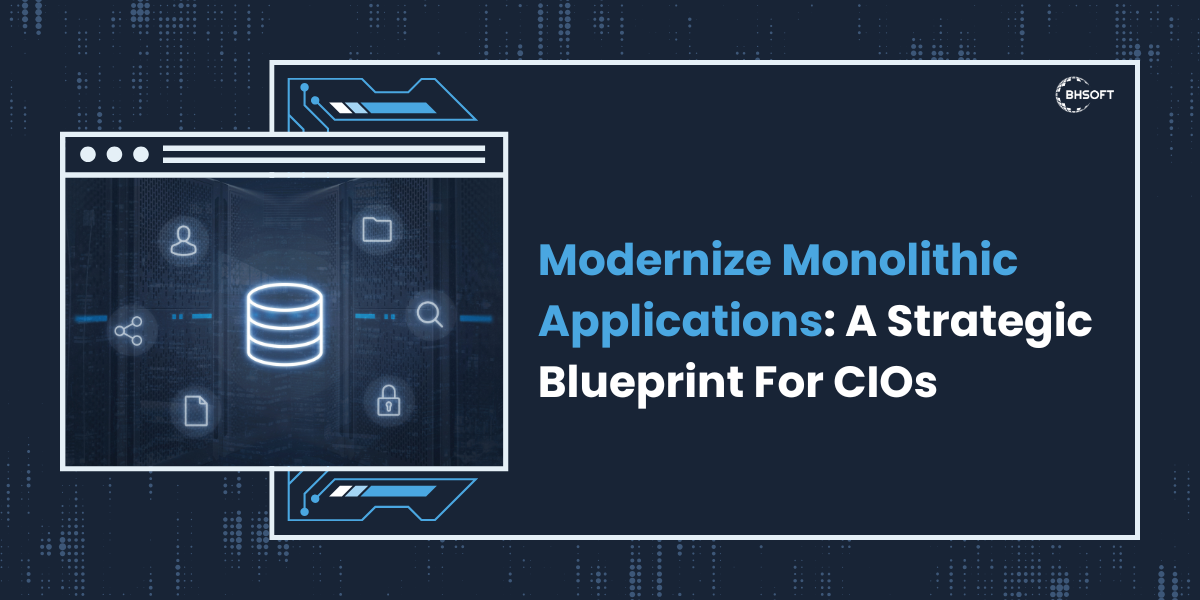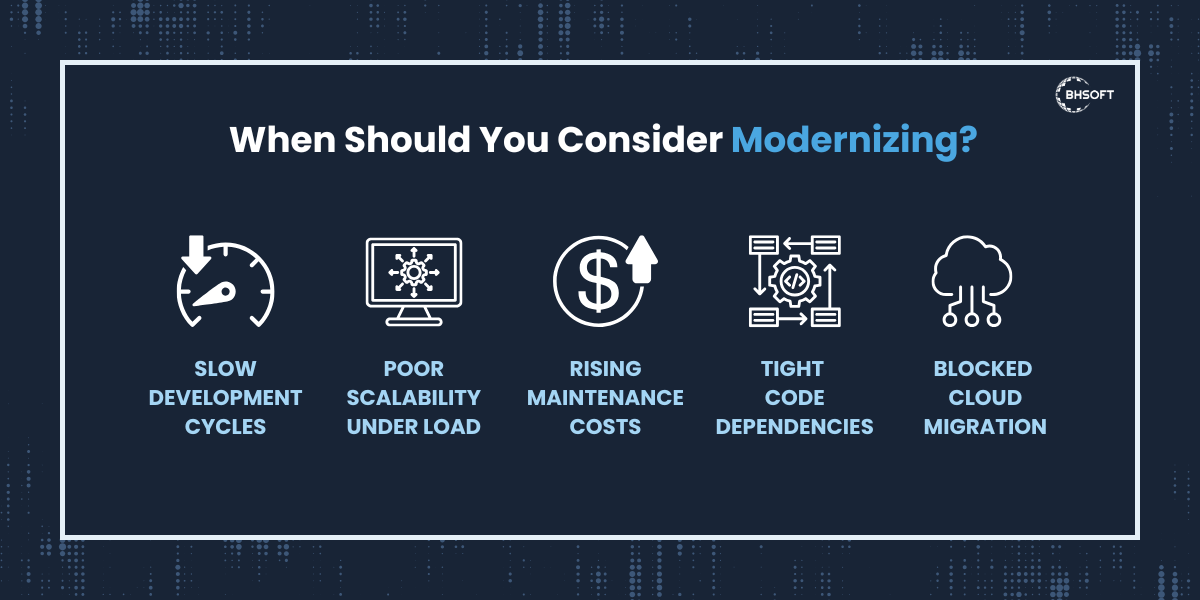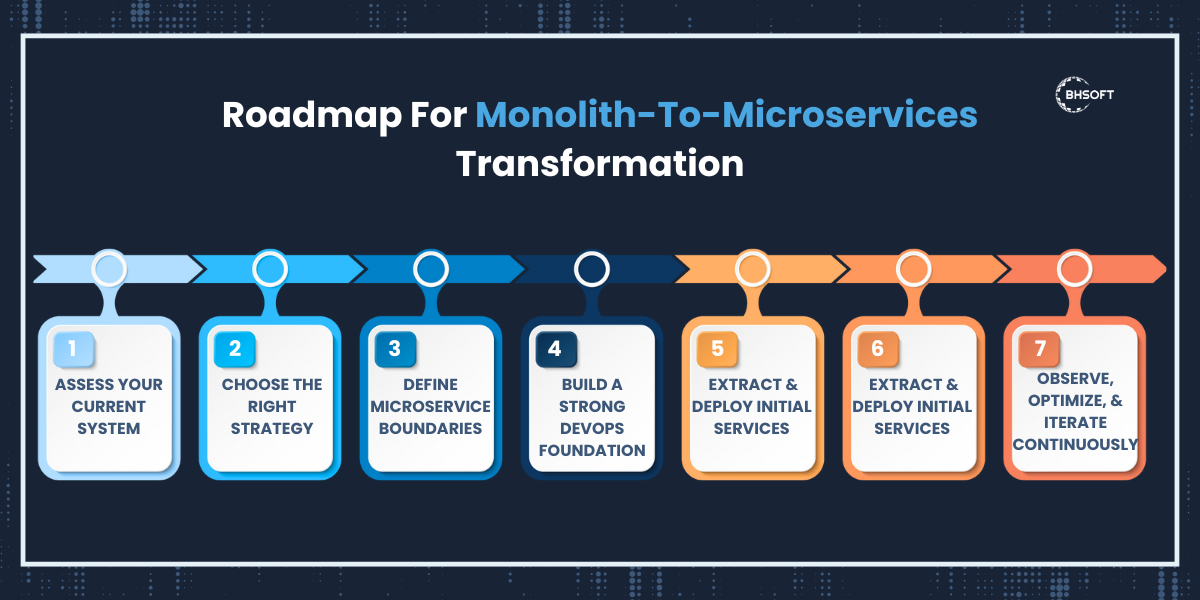Home > Insight > IT Business
Modernize Monolithic Applications: A Strategic Blueprint For CIOs
5 minutes read
Audio description available
April 11, 2025
Software systems built on monolithic architecture often seem functional, until they start slowing everything down. Whether it's long deployment cycles, limited scalability, or downtime that impacts your customers, legacy applications can quickly become a liability. If you're looking for a way to modernize monolithic applications without starting from scratch, transitioning to microservices might be the solution.
In this blog, we’ll explain what that transition looks like, why it matters, and how you can get started. Let’s check it out!

What Is A Monolithic Application?
A monolithic application is a software system where all components (user interface, business logic, and data access) are built into a single unit. Everything is tightly connected and deployed together. At smaller scales, this can be efficient. But as systems grow, this tightly coupled structure becomes harder to manage.
When even a small change requires redeploying the entire application, it slows development down. Testing takes longer. Risks increase. And the cost of maintaining and scaling the application continues to rise.
What Are Microservices?
Microservices are a way to design software as a set of independent, modular services. Each service represents a specific business capability and can be developed, deployed, and scaled independently. These services communicate over lightweight protocols, usually REST or message queues, and often leverage containerization and cloud-native tools.
Microservices enable faster feature delivery, isolated fault tolerance, and greater flexibility in development tools and languages. Each service has its own repository, build process, and often its own data store.
Why Modernize Monolithic Applications Is Essential?
You don’t need to wait for a complete system failure to consider modernization. Many businesses are making the shift proactively because the benefits are too important to ignore.
- Faster Deployment Cycles: Monolithic systems often require weeks or even months to make simple updates. Microservices allow for faster release cycles because each service can be updated on its own.
- Better Scalability: With monolithic systems, scaling one feature often means scaling the entire system. Microservices make it possible to scale only the services that need it.
- Improved Reliability: In monoliths, a single bug can cause the whole system to crash. Microservices isolate these risks.
- Easier Maintenance and Upgrades: Each microservice is small and focused, making it easier to test, update, and manage.
- Alignment with Cloud-Native Development: Microservices are a natural fit for cloud architecture.
According to Gartner, by 2025, over 95% of new digital workloads will be deployed on cloud-native platforms—making microservices and modernization not just beneficial, but essential.
When Should You Consider Modernizing?
Legacy systems are more than just outdated. They're a barrier to agility. IBM reports that nearly 70% of IT leaders say legacy systems are preventing them from responding quickly to market changes and customer needs.
While not every system needs to be modernized immediately, there are clear signs that a monolithic architecture is becoming a liability. You may be reaching that point if:
- Development cycles are slowing
- The system can’t scale easily
- Maintenance costs are rising
- Teams are blocked by code dependencies
- You're moving to the cloud
Learn more: Machine Learning Solutions in Vietnam

How to Modernize: A Step-by-Step Approach
If you’re looking to modernize monolithic applications, a rushed approach can do more harm than good. Modernization isn’t a one-time overhaul—it’s a phased, structured process that unfolds over time. Transitioning from a monolith to microservices requires careful planning, a strong understanding of your system’s architecture, and the right DevOps foundation. The most successful transformations are incremental, driven by technical insight, business alignment, and disciplined execution.
Step 1: Assess your current system
Before making any architectural decisions, start with a thorough assessment of your existing system. This includes:
- Codebase analysis: Use tools like SonarQube or Structure101 to detect high-complexity modules and tight coupling.
- Dependency mapping: Document internal dependencies between services, shared libraries, and third-party integrations.
- Business capability mapping: Identify which components align with core business functions, and prioritize based on their stability, volatility, and domain relevance.
- Service suitability scoring: Evaluate each module's readiness for extraction using metrics like frequency of change, external dependencies, and team ownership.
This assessment helps define logical service boundaries and uncovers architectural blockers before extraction begins.
Step 2: Choose the right strategy
Select the migration path that best suits your current system and business goals:
- Strangler Fig Pattern: Incrementally extract and replace monolithic components with microservices. Use an API Gateway (e.g., Kong, NGINX, Ambassador) to route traffic between legacy and new services.
- Greenfield Rewrite: Rebuild from scratch using a microservices-first approach. Typically used when the legacy system is unmaintainable or lacks long-term viability.
- Hybrid Migration: Start by containerizing the monolith for cloud readiness while gradually introducing new microservices.
The strangler pattern is most common, offering minimal disruption and continuous delivery throughout the transformation.
Step 3: Define microservice boundaries using domain-driven design (DDD)
Clear service boundaries are critical. Apply DDD principles to identify bounded contexts—self-contained business capabilities that can be owned, developed, and deployed independently.
- Examples of bounded contexts: user identity, payment processing, product catalog, inventory, reporting.
- Best practice: Align service boundaries with team responsibilities using the “team-per-service” model from Team Topologies.
- Each microservice should:
- Own its own domain model and schema
- Be independently deployable
- Expose a well-defined API (REST, gRPC, GraphQL, etc.)
Avoid premature over-splitting. Over-fragmentation increases complexity without adding value.

Step 4: Build a strong DevOps & infrastructure foundation
To deploy and manage microservices effectively, invest in a robust DevOps toolchain and containerized infrastructure:
- Infrastructure as Code (IaC): Use Terraform or Pulumi to provision environments reproducibly.
- Containerization: Package each service with Docker and follow best practices for image size, build speed, and security.
- Orchestration: Use Kubernetes (or alternatives like ECS or Nomad) to manage deployment, scaling, and service health.
- CI/CD pipelines: Set up per-service pipelines using GitHub Actions, GitLab CI, Jenkins, or Argo CD.
- Testing layers:
- Unit tests (xUnit, JUnit, etc.)
- Integration tests using in-memory databases or test containers
- Contract tests with Pact to validate service interactions
- Security & compliance: Implement secret management, audit logging, and policy enforcement from day one.
Treat every service as a product with its own lifecycle and SLAs.
Step 5: Extract and deploy initial services
Start small. Select a low-risk, loosely coupled module for your first microservice—something like authentication, search, or notifications.
- Refactor shared code: Move shared logic (e.g., validation, DTOs) into internal libraries or service-specific utilities to reduce coupling.
- API-first development: Design the microservice’s contract before building the implementation.
- Backward compatibility: Ensure existing consumers of the monolith continue to function during the transition. Use anti-corruption layers to bridge legacy interfaces.
- Progressive deployment: Use feature flags, blue-green deployments, or canary releases to test in production safely.
Over time, increase the complexity of services you extract, using insights gained from earlier phases.
Step 6: Extract and deploy initial services
One of the most complex steps in modernization is moving away from a shared monolithic database. Microservices should own their own data.
- Assign data ownership: Only one service should be the source of truth for a given data domain.
- Use independent schemas: Services should not directly access each other’s databases.
- Introduce asynchronous messaging:
- Publish events to Kafka or RabbitMQ for other services to consume
- Use outbox patterns to ensure reliable delivery
- Consistency models:
- Use eventual consistency where strict consistency isn’t required
- For transactional needs across services, explore sagas or orchestration patterns
Proper data isolation ensures long-term scalability and independence of services.
Step 7: Observe, optimize, and iterate continuously
With services in place, shift focus to operational excellence and continuous improvement:
- Monitoring & Observability:
- Use Prometheus for metrics, Grafana for dashboards
- Log aggregation with ELK or Loki
- Distributed tracing with OpenTelemetry or Jaeger
- Service health checks: Enable liveness and readiness probes in Kubernetes.
- Alerting: Use alerting tools to detect latency spikes, error rates, or failed deployments.
- Performance testing: Use tools like K6 or Locust to simulate load and validate scalability.
- Granularity review: Periodically reassess whether services are too coarse or overly granular.
Optimization doesn’t end at deployment. A microservices ecosystem needs constant tuning as it scales.
Common Challenges And How To Overcome Them
Modernization projects come with technical and organizational friction. Below are common roadblocks—and ways to move past them.
Increased Complexity and Service Overhead
Microservices introduce inter-service communication, latency, and failure management.
- How to manage: Adopt a service mesh for traffic control, retries, and observability. Design contracts and use async messaging where feasible.
Decentralized Data Ownership
Breaking apart a shared monolithic database can cause confusion around data access and integrity.
- How to manage: Assign strict data ownership to services and implement event-based communication. Avoid dual writes and shared schemas.
Lack of Test Coverage in Legacy Code
Refactoring without tests is risky.
- How to manage: Introduce contract testing between services and wrap legacy endpoints with minimal tests to validate stability before decoupling.
Observability Gaps
Multiple services mean fragmented logs, metrics, and traces.
- How to manage: Standardize logging formats, use centralized log aggregation, and implement distributed tracing (OpenTelemetry, Jaeger).
Resistance to Change
Stakeholders and engineers may hesitate due to perceived risk or learning curve.
- How to manage: Start with a pilot service, demonstrate benefits, and scale gradually. Provide upskilling paths and build internal champions.
Final Thoughts
Modernizing from a monolith to microservices is a strategic decision that improves how your business builds, scales, and delivers software.
Yes, it requires time and investment—but the result is a foundation that is faster, more resilient, and adaptable to the needs of modern businesses.
From reducing technical debt to enabling continuous innovation, modernization is about aligning IT with your long-term vision. For CIOs, it’s an opportunity to drive transformation that creates measurable business value.
At BHSOFT, we help companies modernize legacy applications without disrupting business continuity. If you're ready to modernize monolithic applications, let’s talk.
Frequently Asked Questions (FAQ)
1. How do I know when it's the right time to modernize our monolithic system?
- If you're experiencing deployment delays, scaling limitations, or rising maintenance costs, now may be the right time to start.
2. Can we run microservices without containers?
- You can, but containers offer greater isolation, deployment automation, and scalability. Most modern microservices use Docker and Kubernetes.
3. What’s the best way to secure microservices?
- Use API gateways for centralized authentication and policy enforcement, TLS encryption for communication, and secure token-based authentication (OAuth2, JWT).
4. Should every microservice have its own database?
- Yes. Each service should have ownership of its data to avoid tight coupling and ensure service independence.
5. Will microservices hurt performance?
- With proper observability and efficient APIs, any performance tradeoffs are offset by the flexibility and resilience gains.

